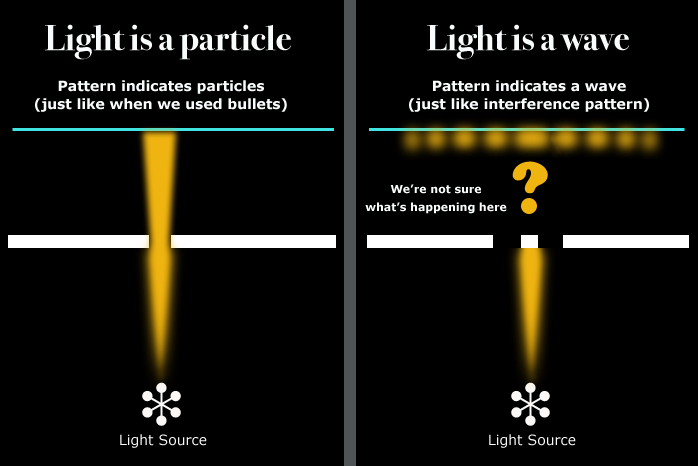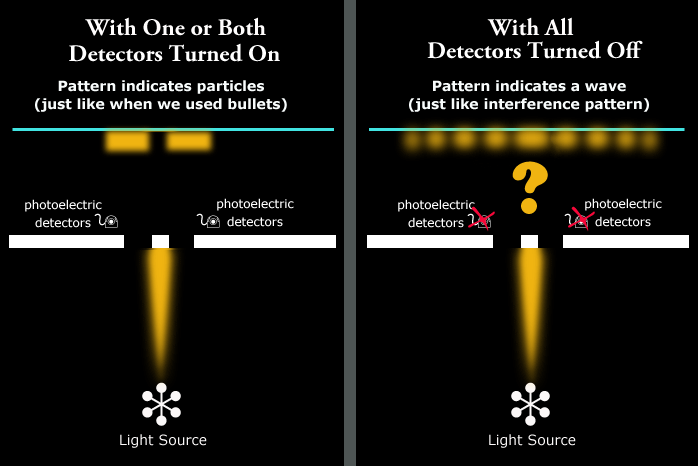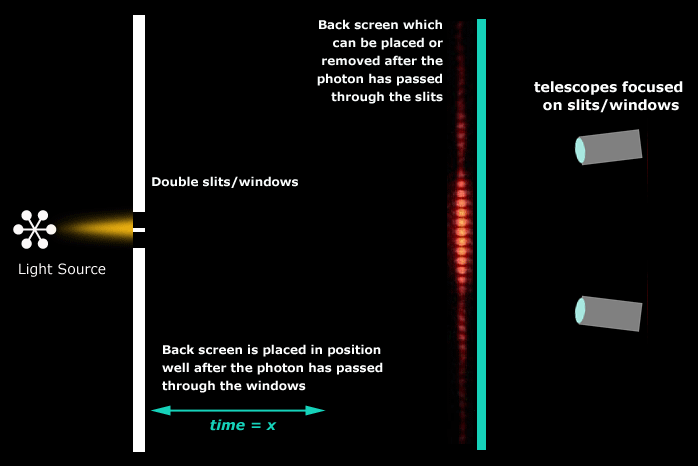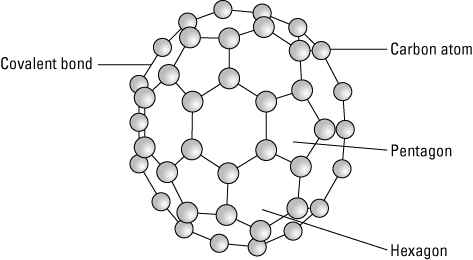

The Unexpected Happens
Many of you may have learned about this experiment in your physics class. But there is a new twist that I will tell you about later that will totally blow your mind...
When a single beam of light was directed at the single slit (or window), the light cast a pattern of a fuzzy rectangle -- the same shape as the window. This is a clear example that light is made of individual particles. We call these particles photons. In physics a photon is an elementary particle (meaning it is not made up of smaller bits and pieces) and it has a unitary size and charge.
So when a single beam of light is directed at a double slit (or two windows) we would expect it to behave much like the bullets in our imaginary experiment and cast two fuzzy rectangles. But it doesn't. Instead we get the interference pattern, indicative of a wave (see below).

For an interference pattern to happen, we assume that something went through both slits (windows) at the same time. Scientists first thought that two photons are somehow passing through the two windows at the same time, then interfering with each other after they have passed through their respective window and before they strike the back wallboard.
To eliminate this possibility, they managed to fired a single photon at the windows... then another... then another. The wallboard was designed so that the location of each photon could be marked, much like the bullet holes. They were now certain that only one photon was passing through either window at any time. But after a while they noticed the same interference pattern. The places where the photons had hit the backboard were arranged in a pattern of bands and gaps. How could this be happening?
This was so strange that some theorists suggested the photon had somehow split itself in two, gone through separate windows and then recombined. Since it is an elementary particle, this is not possible. So the next idea was to try and see where each photon was going, one at a time, and try to undersand what was happening to it before it hit the wallboard.
The experimenters decided to place some photo-electric cells on the back sides of the windows so that they cold "see" which window the photon went through, then they would monitor where it landed on the backboard. Since light travels in a straight line they would be able to plot the photon's course and see what was causing the interference pattern.
But that just created more problems (see below).

As soon as a detector was turned on to see the photon pass by, the arrangement of the photons striking the back wall were indicative of a particle. They tried turning one detector on, then the other, then both -- no matter what combination they tried, if they knew which window the photon passed through the experimental results were always indicative of a particle. As soon as they stopped trying to see which window the photon went through, the wave interference pattern appeared.
It appears that whenever we know which window/slit the proton passed through, the result will always be the characteristic pattern of a particle. If we do not know which slit the proton passed through, the result will always be characteristic of an interference pattern.
Why Observation Changes The Results
To measure the photon passing through the window, the apparatus used a detector that shot its own photons across the gap and collected it on the opposite side. If this beam of photons encountered the experimental photon that had passed through the window, its trajectory would be changed and this change would be noted. But experimenters knew that the experimental photon would also be changed, ever so slightly.
Apparently there is no way to observe the experimental photon passing through the window without altering its path. They soon learned that any time they could detect through which window (or slit) the experimental photon passed, this detection would somehow make the photon behave as if it were a particle.
At one point they reduced the photons in the detector to the point where the detector sometimes would catch the experimental photon and other times it would pass undetected. They noticed when they did this that if the detector could track the experimental photon it landed inside one of the two fuzzy rectangles but for those that escaped detection they would land in one of the interference bands.
Somehow the act of observation was changing the experimental results. But how?
It gets even stranger!
When does the photon change from one form to the other? Does it happen when the particle is being detected? Could the mere act of detection be enough to collapse the wave and form a particle pattern?
To test his hypothesis a man named John A. Wheeler designed an ingenious way of altering the double slit experiment that would, he thought, prove that the process of detection was not responsible for the change from particle to wave patterns.
First, Wheeler had two powerful telescopes -- one focused on each slit. If a photon went through one or the other slit, the telescopes could see it. The telescopes were placed where the fuzzy rectangles would register a photon hit from a particle pattern. Since the light had to travel to the telescopes, they served as a detector.
Wheeler then devised a detection screen that could be very quickly placed in front of the telescopes, preventing them from seeing the slits but recording where the photons landed.
The mechanism was constructed so that the distance between the wall with the slits was quite far from both the removable detection wall and the telescopes.
Becase these distances and speed of light were known, it was possible to know when a photon had been released, passed through either or both of the slits and was somewhere between the slits and the detectors. We call this time =x in the animation below. At this precise moment the detection screen could either be placed in front of the telescopes or removed.
[See animation below]

The idea was that the photon should have already decided if it was going to react like a particle or a wave after it had passed through the slits. And this decision by the photon should be irreversible.
Wheeler tried to force the photon to be a particle because, at the time it passed through the slits, it was being watched by the telescopes. By putting up the screen after the photon passed the slits, but before the telescopes received the light, he expected the photon would act like a particle. (Is your head spinning yet?)
In the actual experiment, when the photons passed through the slits, if the detector wall was quickly put in place, they displayed the wave pattern on the wall. But, if after the photons passed through the slits, the detector wall was suddenly removed, the telescopes would capture the photons in the area where two fuzzy rectangles would be -- indicative of a particle.
In other words, the decision on which type of detection is used (screen or telescopes) is being made after the photons have passed through the slits -- presumable after they have already decided to be a wave or a particle. Yet, the later decision seems to somehow influence the photon in the past. Huh?
Ordinarily we have "cause--effect" timelines in nature. But this experiment seems to show that the effect can change the cause.
In other experiments, the detectors were used to determine which slit the photon passed BUT the electronics that reported or recorded the result were turned off. This is the so-called Earasure Paradox because, despite being detected, the interference pattern resulted. It seems that it is not the detection that matter as much as whether a person (human being) is aware of it or not!
More weirdness: Electrons and Buckyballs
Not surprising, when electrons are used in a vacuum environment instead of photons, the results are identical. But what astonished me was that something as large as a 60 atom molecule -- a so-called "buckyball" -- also displayed this mind-bending feat!
Just how big a molecule needs to be before it continually displays the particle pattern is something that is currently being explored.1
| What is a buckyball (C60)?
Buckyballs, also called fullerenes, were one of the first nanoparticles discovered. This discovery happened in 1985 by a trio of researchers working out of Rice University named Richard Smalley, Harry Kroto, and Robert Curl.
 Buckyballs are composed of carbon atoms linked to three other carbon atoms by covalent bonds. However, the carbon atoms are connected in the same pattern of hexagons and pentagons you find on a soccer ball, giving a buckyball the spherical structure as shown in the following figure. The most common buckyball contains 60 carbon atoms and is sometimes called C60.Other sizes of buckyballs range from those containing 20 carbon atoms to those containing more than 100 carbon atoms. The covalent bonds between carbon atoms make buckyballs very strong, and the carbon atoms readily form covalent bonds with a variety of other atoms. Buckyballs are used in composites to strengthen material. Buckyballs have the interesting electrical property of being very good electron acceptors, which means they accept loose electrons from other materials. This feature is useful, for example, in increasing the efficiency of solar cells in transforming sunlight into electricity. [Excerpt from Nanotechnology For Dummies (2nd edition), from Wiley Publishing]
|
Things To Remember...
While you are trying to get your mind around this, it's perhaps time to answer some frequently asked questions about the wave and particle patterns. Remember that even with the wave pattern, the detector wall in the photon experiments is detecting whole, single photons which are all of uniform size and charge. The detector can only detect these uniform particles -- and they are most certainly particles when they are detected -- however it is the pattern which appears over time that forms the distinct interference bands and gaps or the fuzzy rectangles.
So before they are detected, it would seem, they are influenced by something to land randomly in a pattern of either wave or particle. Once they are detected they are particles. Yet, as we saw in the last experiment -- incidentally called the "delayed choice" version of the Double Slit Experiment -- the decision appears to have been made prior to detection yet dependent upon the subsequent choice of the detection method... whew!
Yes, there's more, if you can handle it. That will be in the next installment on light.
In the meantime, a reader sent me a link to a lecture by Tom Campbell on YouTube. I thought I'd heard almost all of the explanations for the paradox of the Double Split Experiment and Delayed Decision stuff but Campbell surprised me by stating the obvious conclusion that most scientists come to when trying to explain things on the quantum level: it's not real! We are part of a simulation. Reality is either a digital simulation itself, or reality is running on some larger system of things we cannot have knowledge about.
It's cutting edge thinking and it will expand your ideas about reality beyond your imagination. I'll try to get a hold on it and write more. Meanwhile, here is that video. Enjoy.
1 - New Scientist: Quantum wonders: Corpuscles and buckyballs, 2010
Comments:
Nature: Wave-particle duality of C60 molecules, 14 October 1999. Abstract
